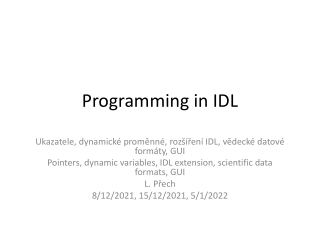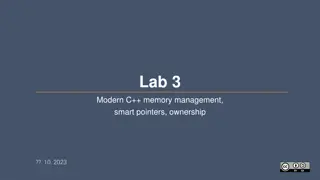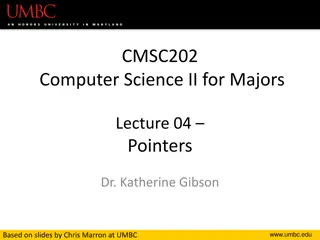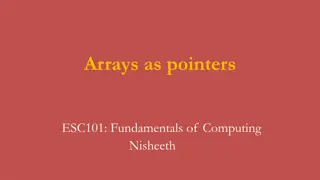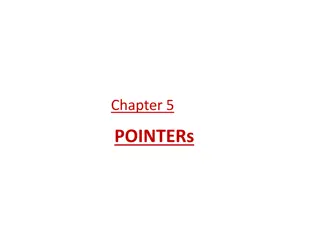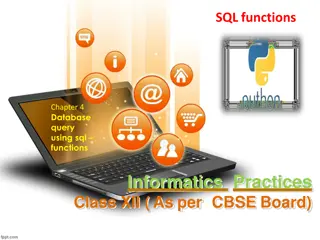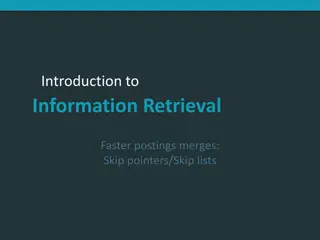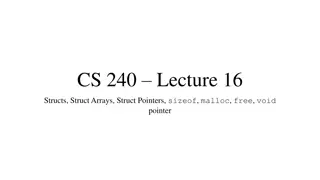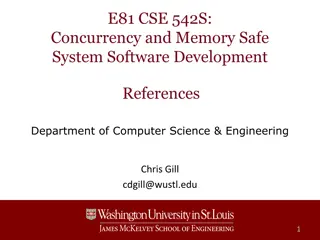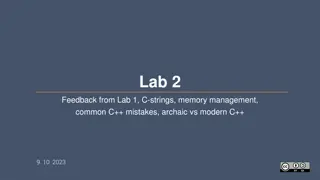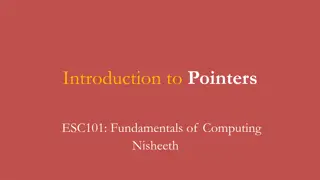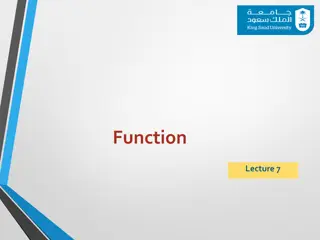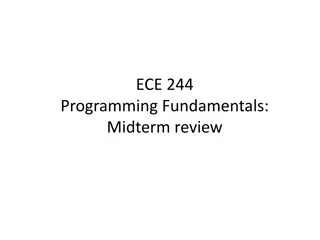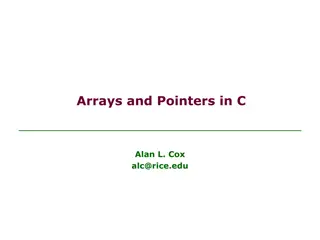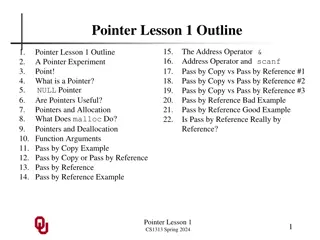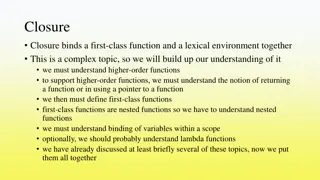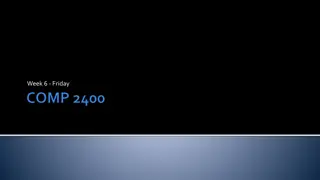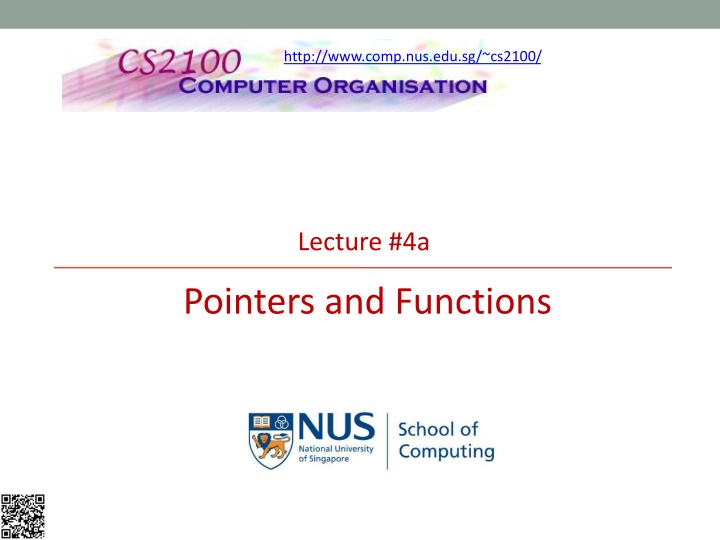
Pointers and Functions in C Programming
Explore the concept of pointers and functions in C programming through Aaron Tan's NUS Lecture #4. Learn about pointer variables, calling functions, pass-by-value, and more. Understand how C's structure, including pointers, allows for efficient memory manipulation and bitwise operations.
Download Presentation

Please find below an Image/Link to download the presentation.
The content on the website is provided AS IS for your information and personal use only. It may not be sold, licensed, or shared on other websites without obtaining consent from the author. If you encounter any issues during the download, it is possible that the publisher has removed the file from their server.
You are allowed to download the files provided on this website for personal or commercial use, subject to the condition that they are used lawfully. All files are the property of their respective owners.
The content on the website is provided AS IS for your information and personal use only. It may not be sold, licensed, or shared on other websites without obtaining consent from the author.
E N D
Presentation Transcript
http://www.comp.nus.edu.sg/~cs2100/ Lecture #4a Pointers and Functions
Questions? IMPORTANT: DO NOT SCAN THE QR CODE IN THE VIDEO RECORDINGS. THEY NO LONGER WORK Ask at https://sets.netlify.app/module/676ca3a07d7f5ffc1741dc65 OR Scan and ask your questions here! (May be obscured in some slides)
Aaron Tan, NUS Lecture #4: Pointers and Functions 3 Lecture #4: Pointers and Functions (1/2) 1. Pointers 1.1 Pointer Variable 1.2 Declaring a Pointer 1.3 Assigning Value to a Pointer 1.4 Accessing Value Through Pointer 1.5 Example #1 1.6 Example #2 1.7 Tracing Pointers 1.8 Incrementing a Pointer 1.9 Common Mistake 1.10 Why Do We Use Pointers?
Aaron Tan, NUS Lecture #4: Pointers and Functions 4 Lecture #4: Pointers and Functions (2/2) 2. Calling Functions 3. User-Defined Functions 4. Pass-by-Value and Scope Rule 4.1 Consequence of Pass-by-Value 5. Functions with Pointer Parameters 5.1 Function to Swap Two Variables 5.2 Examples
Aaron Tan, NUS Lecture #4: Pointers and Functions 5 1. Pointers (1/3) While C is a high-level programming language, it is usually considered to be at the lower end of the spectrum due to a few reasons, among which are: It has pointers which allow direct manipulation of memory contents It has a set of bit manipulation operators, allowing efficient bitwise operations In Lecture #2a slide 11, we say that a variable has a name (identifier); a data type; and an address.
Aaron Tan, NUS Lecture #4: Pointers and Functions 6 1. Pointers (2/3) Name Data type A variable occupies some space in the computer memory, and hence it has an address. The programmer usually does not need to know the address of the variable (she simply refers to the variable by its name), but the system keeps track of the variable s address. int a; a = 123; May only contain integer value a 123 Where is variable a located in the memory?
Aaron Tan, NUS Lecture #4: Pointers and Functions 7 1. Pointers (3/3) You may refer to the address of a variable by using the address operator & (ampersand) Address.c int a = 123; printf("a = %d\n", a); printf("&a = %p\n", &a); a = 123 &a = ffbff7dc %p is used as the format specifier for addresses Addresses are printed out in hexadecimal (base 16) format The address of a variable varies from run to run, as the system allocates any free memory to the variable
Aaron Tan, NUS Lecture #4: Pointers and Functions 8 1.1 Pointer Variable A variable that contains the address of another variable is called a pointer variable, or simply, a pointer. Example: a pointer variable a_ptr is shown as a blue box below. It contains the address of variable a. a a_ptr Assuming that variable a is located at address ffbff7dc. ffbff7dc 123 Variable a_ptr is said to be pointing to variable a. If the address of a is immaterial, we simply draw an arrow from the blue box to the variable it points to. a a_ptr 123
Aaron Tan, NUS Lecture #4: Pointers and Functions 9 1.2 Declaring a Pointer Syntax: type *pointer_name; pointer_name is the name (identifier) of the pointer type is the data type of the variable this pointer may point to Example: The following statement declares a pointer variable a_ptr which may point to any int variable Good practice to name a pointer with suffix _ptr or _p int *a_ptr;
Aaron Tan, NUS Lecture #4: Pointers and Functions 10 1.3 Assigning Value to a Pointer Since a pointer contains an address, only an address may be assigned to a pointer Example: Assigning address of a to a_ptr int a = 123; int *a_ptr; // declaring an int pointer a_ptr = &a; a_ptr a 123 We may initialise a pointer during its declaration: int a = 123; int *a_ptr = &a; // initialising a_ptr
Aaron Tan, NUS Lecture #4: Pointers and Functions 11 Visualization int a = 123; int *a_ptr; a_ptr = &a; address ffbff7dc name a value 123 ffbff7ff 1234567890 ffbff7dc a_ptr
Aaron Tan, NUS Lecture #4: Pointers and Functions 12 1.4 Accessing Variable Through Pointer a_ptr a 123 Once we make a_ptr points to a (as shown above), we can now access a directly as usual, or indirectly through a_ptr by using the indirection operator (also called dereferencing operator) * printf("a = %d\n", *a_ptr); printf("a = %d\n", a); *a_ptr = 456; a = 456; Hence, *a_ptr is synonymous with a
Aaron Tan, NUS Lecture #4: Pointers and Functions 13 1.5 Example #1 12 12 i j int i = 10, j = 20; int *p; // p is a pointer to some int variable 10 20 p p = &i; // p now stores the address of variable i Important! Now *p is equivalent to i value of i is 10 printf("value of i is %d\n", *p); // *p accesses the value of pointed/referred variable *p = *p + 2; // increment *p (which is i) by 2 // same effect as: i = i + 2; p = &j; // p now stores the address of variable j Important! Now *p is equivalent to j *p = i; // value of *p (which is j now) becomes 12 // same effect as: j = i;
Aaron Tan, NUS Lecture #4: Pointers and Functions 14 1.6 Example #2 (1/2) a Pointer.c #include <stdio.h> b Can you draw the picture? What is the output? int main(void) { double a, *b; 12.340000 What is the output if the printf() statement is changed to the following? b = &a; *b = 12.34; printf("%f\n", a); printf("%f\n", *b); 12.340000 printf("%f\n", b); Compile with warning return 0; } printf("%f\n", *a); Error Value in hexadecimal; varies from run to run. What is the proper way to print a pointer? (Seldom need to do this.) printf("%p\n", b); ffbff6a0
Aaron Tan, NUS Lecture #4: Pointers and Functions 15 1.6 Example #2 (2/2) How do we interpret the declaration? double a, *b; The above is equivalent to double a;// this is straight-forward: a is a double variable double *b; We can read the second declaration as *b is a double variable, so this implies that ... b is a pointer to some double variable The following are equivalent: double a; double *b; b = &a; double a; double *b = &a; But this is not the same as above (and it is not legal): double a; double b = &a;
Aaron Tan, NUS Lecture #4: Pointers and Functions 16 End of File

